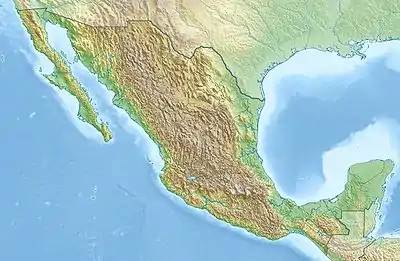Sistema Sac Actun
Sistema Sac Actun (from Spanish and Yucatec Maya meaning "White Cave System") is an underwater cave system situated along the Caribbean coast of the Yucatán Peninsula with passages to the north and west of the village of Tulum. Discovery of a connection to the Sistema Dos Ojos in 2008 made it the longest known underwater cave system.
| Sistema Sac Actun | |
|---|---|
 Gran Cenote | |
 Sistema Sac Actun Location in Mexico | |
| Location | Tulum Municipality, Quintana Roo, Mexico |
| Coordinates | 20°14′47.6″N 87°27′50.8″W |
| Depth | 119.2 meters (391 ft)[1] |
| Length | underwater: 364.396 kilometers (226.425 mi)[1] total: 371.958 kilometers (231.124 mi)[2] |
| Discovery | November 26, 1987 |
| Geology | Limestone |
| Entrances | 187 Cenotes[1] |
| Difficulty | Advanced cave diving |
The remains of a mastodon and a human female that might be the oldest evidence of human habitation in this area to date have been found in the cave.
History of exploration
Exploration started from Gran Cenote 5 kilometers (3.1 mi) west of Tulum. The whole of the explored cave system lies within the Municipality of Tulum (state of Quintana Roo).
In early 2007, the underwater cave Sistema Nohoch Nah Chich was connected into and subsumed into Sac Actun making it the longest surveyed underwater cave system in the world.[3]
Sac Actun measured 230.8 kilometers (143.4 mi) (after connecting Sistema Aktun Hu with 34 kilometers (21 mi) in January 2011) and is as of May 2017 with an explored length of 259.5 kilometers (161.2 mi) only surpassed by Sistema Ox Bel Ha at 270.2 kilometers (167.9 mi).[1] Since early 2007, these two caves frequently exchanged the title of the longest Quintana Roo Speleological Survey underwater cave system in the world.[4] Including connected dry caves makes Sistema Sac Actun with 364.4 kilometers (226.4 mi) the longest cave in Mexico[2] and the second longest worldwide.[5]
In 2018, the discovery of a link between the Sac Actun system (reported to be 263 km long) and the Dos Ojos system in Tulum, Quintana Roo (84 km long) was reported.[6] The connection was found by the Gran Maya Aquifer Project (GAM), led by the cave diver and explorer, Robbie Schmittner.[7] The combined system is reported to be the world's largest underwater cave system known.
Upper Paleolithic remains
In March 2008, three members of the Proyecto Espeleológico de Tulum and Global Underwater Explorers dive team, Alex Alvarez, Franco Attolini, and Alberto Nava, explored a section of Sistema Aktun Hu known as the pit Hoyo Negro.[8][9] At a depth of 57 meters (187 ft) the divers located the remains of a mastodon, as well as at 43 meters (141 ft) a human skull that might be the oldest evidence of human habitation in this area.[9] Additional bones were located and the skeleton was later identified as that of a teenage female now referred to as Naia.[10]
See also
- Eve of Naharon
- List of caves – Wikipedia list article
- List of caves in Mexico
- List of sinkholes of Mexico – Links to Wikipedia articles on sinkholes, blue holes, dolines, cenotes, and pit caves
- Paleo-Indians – Classification term given to the first peoples who entered the American continents
- Settlement of the Americas – Prehistoric migration from Asia to the Americas
- Speleology – Science of cave and karst systems
References
- "List of Long Underwater Caves in Quintana Roo Mexico". Quintana Roo Speleological Survey. National Speleological Society (NSS). January 1, 2020. Retrieved March 24, 2020.
- "Dry Caves and Sumps of Quintana Roo Mexico". Quintana Roo Speleological Survey. National Speleological Society. January 1, 2017. Retrieved May 26, 2017.
- John Roach (March 5, 2007). "World's Longest Underground River Discovered in Mexico". National Geographic News. National Geographic. Retrieved January 14, 2011.
- Michael Poucher, Bob Gulden (March 21, 2017). "World longest underwater caves". Geo2 Committee on Long and Deep Caves. NSS. Retrieved May 26, 2017.
- Bob Gulden (January 22, 2020). "Worlds longest caves". Geo2 Committee on Long and Deep Caves. NSS. Retrieved March 24, 2020.
- "Underwater cave is the world’s biggest", Mexico Daily News, January 15, 2018, https://mexiconewsdaily.com/news/underwater-cave-is-worlds-biggest/ (accessed 2018-01-17).
- "World's Largest Underwater Cave Discovered". National Geographic News. 2018-01-17. Retrieved 2020-05-11.
- "Cave Archeology of Early Americans" (PDF). News from the Field. El Centro Investigador del Sistema Aquífero de Quintana Roo: 6. Winter 2011. Archived from the original (PDF) on 2015-02-06. Retrieved October 10, 2013.
- Fabio Esteban Amador (February 18, 2011). "Skull in Underwater Cave May Be Earliest Trace of First Americans". NatGeo News Watch. National Geographic. Retrieved February 19, 2011.
- Hodges, Glen (2014-05-14). "Most Complete Ice Age Skeleton Helps Solve Mystery of First Americans". National Geographic.
- Steve Gerrard (2000). The Cenotes of the Riviera Maya. ISBN 0-9677412-0-3. online Version. Retrieved January 14, 2011.
Chetumal (capital) | |||||||||||
| Municipalities (seats) |
|  | |||||||||
| Places of interest |
| ||||||||||
| |||||||||||||||||||||||||||||||||||||
| |||||||||||||||||||||||||||||||||||||
| |||||||||||||||||||||||||||||||||||||
| |||||||||||||||||||||||||||||||||||||
| |||||||||||||||||||||||||||||||||||||
| |||||||||||||||||||||||||||||||||||||
| |||||||||||||||||||||||||||||||||||||
| |||||||||||||||||||||||||||||||||||||
| |||||||||||||||||||||||||||||||||||||
| |||||||||||||||||||||||||||||||||||||
| |||||||||||||||||||||||||||||||||||||
| |||||||||||||||||||||||||||||||||||||
| |||||||||||||||||||||||||||||||||||||
| |||||||||||||||||||||||||||||||||||||
| |||||||||||||||||||||||||||||||||||||
